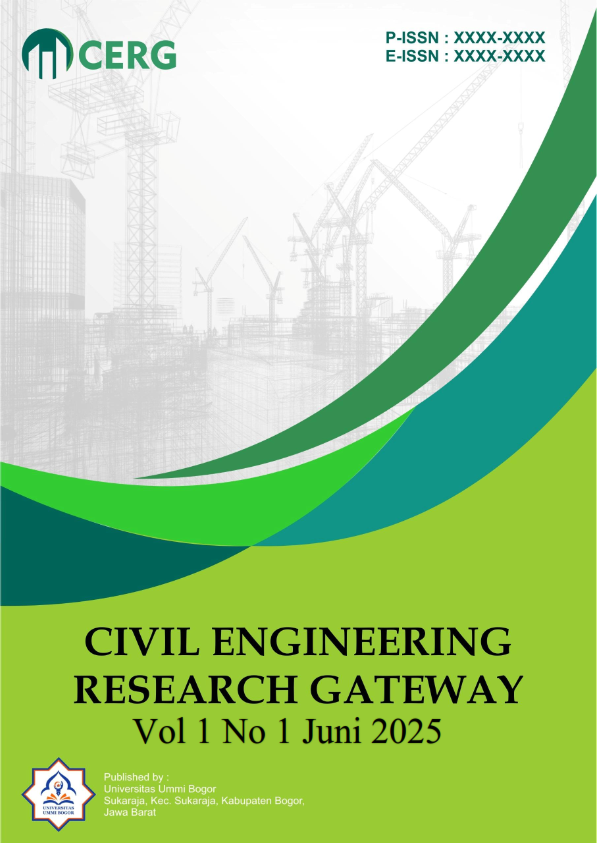Advancing Civil Engineering through Smart Materials, Green Construction, and Digital Technologies
Keywords:
Civil Engineering, Digital Technologies, Green Construction, Smart Materials, SustainabilityAbstract
Civil engineering is entering a transformative era shaped by the convergence of smart materials, green construction practices, and digital technologies, which together address the pressing challenges of sustainability, resilience, and efficiency in the built environment. Traditional construction methods, while foundational, often fall short in meeting the demands of modern urbanization, climate change, and resource constraints. This study aims to explore how the integration of innovative materials and technologies can advance civil engineering practices toward creating infrastructures that are both sustainable and adaptable. The research adopts a qualitative descriptive approach by analyzing relevant literature, technological applications, and case studies across various construction projects. Through this method, it identifies key themes such as the role of smart materials in enhancing structural performance and durability, the significance of green construction practices in reducing environmental footprints, and the potential of digital technologies like Building Information Modeling (BIM), Geographic Information Systems (GIS), and modular integrated construction to improve planning, efficiency, and resilience. The findings reveal that these three dimensions are not isolated but mutually reinforcing, as smart materials enable eco-friendly designs, green construction fosters responsible practices, and digital technologies enhance coordination and decision-making. The implications highlight that adopting these integrated approaches can lead to the development of future-ready infrastructure capable of withstanding environmental uncertainties while promoting economic and social sustainability. This study underscores the necessity for civil engineers, policymakers, and industry stakeholders to embrace innovation, interdisciplinary collaboration, and long-term planning in order to ensure the continued evolution of the construction industry in line with global sustainability goals.
References
Abioye, S. O., Oyedele, L. O., Akanbi, L. A., Ajayi, A. O., Delgado, J. M. D., Akinade, O. O., & Davila Delgado, J. M. (2021). Artificial intelligence in the construction industry: A review of present status, opportunities and future challenges. Journal of Building Engineering, 44, 103299. https://doi.org/10.1016/j.jobe.2021.103299
Baruch, Y., & Holtom, B. C. (2008). Survey response rate levels and trends in organizational research. Human Relations, 61(8), 1139–1160. https://doi.org/10.1177/0018726708094863
Bartlett, J. E., Kotrlik, J. W., & Higgins, C. C. (2001). Organizational research: Determining appropriate sample size in survey research. Information Technology, Learning, and Performance Journal, 19(1), 43–50.
Braun, V., & Clarke, V. (2019). Reflecting on reflexive thematic analysis. Qualitative Research in Sport, Exercise and Health, 11(4), 589–597. https://doi.org/10.1080/2159676X.2019.1628806
Creswell, J. W., & Creswell, J. D. (2018). Research design: Qualitative, quantitative, and mixed methods approaches (5th ed.). SAGE Publications.
Creswell, J. W., & Plano Clark, V. L. (2018). Designing and conducting mixed methods research (3rd ed.). SAGE Publications.
Darko, A., Zhang, C., & Chan, A. P. C. (2017). Drivers for green building: A review of empirical studies. Habitat International, 60, 34–49. https://doi.org/10.1016/j.habitatint.2016.12.007
Durdyev, S., Zavadskas, E. K., Thurnell, D., Banaitis, A., & Ihtiyar, A. (2018). Sustainable construction industry in Cambodia: Awareness, drivers and barriers. Sustainability, 10(2), 392. https://doi.org/10.3390/su10020392
Field, A. (2018). Discovering statistics using IBM SPSS statistics (5th ed.). SAGE Publications.
Goh, C. S., & Loosemore, M. (2017). The impacts of industrialization on construction subcontractors: A resource-based view. Construction Management and Economics, 35(5), 288–304. https://doi.org/10.1080/01446193.2016.1248984
Hair, J. F., Black, W. C., Babin, B. J., & Anderson, R. E. (2019). Multivariate data analysis (8th ed.). Cengage Learning.
He, Q., Chen, Y., & Luo, L. (2022). Resilient infrastructure: A systematic review on resilience assessment methods. Sustainable Cities and Society, 81, 103843. https://doi.org/10.1016/j.scs.2022.103843
Joshi, A., Kale, S., Chandel, S., & Pal, D. K. (2015). Likert scale: Explored and explained. British Journal of Applied Science & Technology, 7(4), 396–403. https://doi.org/10.9734/BJAST/2015/14975
Marzouk, M., & Othman, A. (2017). Planning utility infrastructure requirements for smart cities using the integration between BIM and GIS. Sustainable Cities and Society, 35, 263–271. https://doi.org/10.1016/j.scs.2017.08.002
Matarneh, R., & Danso-Amoako, M. (2021). Digital transformation in the construction industry: Insights from an innovation diffusion perspective. Construction Innovation, 21(3), 511–528. https://doi.org/10.1108/CI-08-2020-0143
Opoku, A., & Ahmed, V. (2016). Leadership, culture and sustainable built environment. Buildings, 6(1), 14. https://doi.org/10.3390/buildings6010014
Palinkas, L. A., Horwitz, S. M., Green, C. A., Wisdom, J. P., Duan, N., & Hoagwood, K. (2015). Purposeful sampling for qualitative data collection and analysis in mixed method implementation research. Administration and Policy in Mental Health and Mental Health Services Research, 42(5), 533–544. https://doi.org/10.1007/s10488-013-0528-y
Paton, D., & Buergelt, P. T. (2019). Risk, transformation and resilience: Multidisciplinary insights and societal implications. Sustainability, 11(7), 1970. https://doi.org/10.3390/su11071970
Rogers, E. M. (2003). Diffusion of innovations (5th ed.). Free Press.
Tavakol, M., & Dennick, R. (2011). Making sense of Cronbach’s alpha. International Journal of Medical Education, 2, 53–55. https://doi.org/10.5116/ijme.4dfb.8dfd
Volk, R., Stengel, J., & Schultmann, F. (2014). Building Information Modeling (BIM) for existing buildings — Literature review and future needs. Automation in Construction, 38, 109–127. https://doi.org/10.1016/j.autcon.2013.10.023
Wuni, I. Y., & Shen, G. Q. (2020). Critical success factors for modular integrated construction projects: A review. Building Research & Information, 48(7), 763–779. https://doi.org/10.1080/09613218.2019.1660608
Downloads
Published
Issue
Section
License
Copyright (c) 2025 Civil Engineering Research Gateway

This work is licensed under a Creative Commons Attribution-ShareAlike 4.0 International License.



